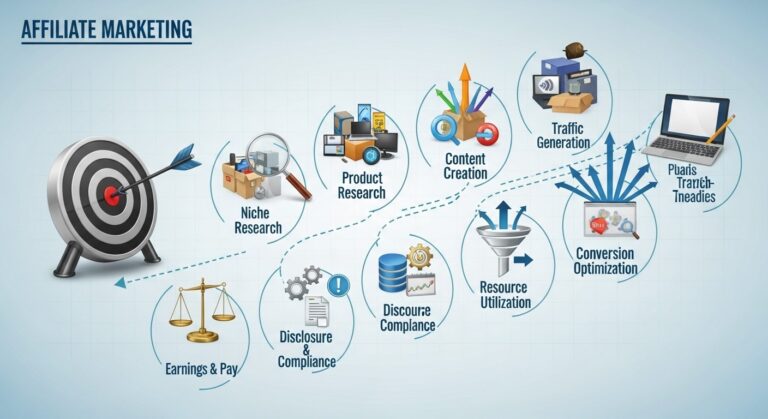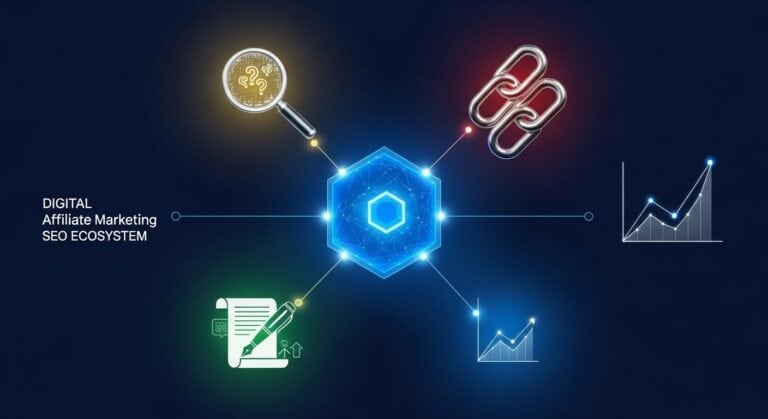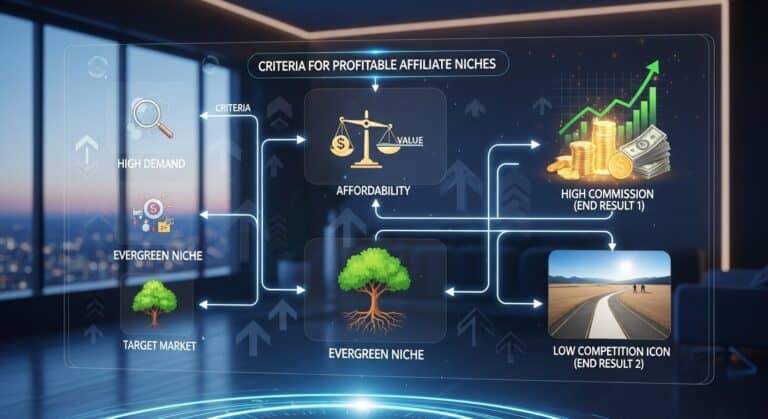How to Monetize Your Blog: Proven Strategies to Earn Income
ULTIMATE 2026 GUIDE TO BUILDING AFFILIATE WEBSITES WITH WORDPRESS PROTOCOL: ACTIVE
ID: REF-2025-E8C3FConclusions built strictly upon verifiable data and validated research.
Assertions undergo meticulous fact-checking against primary sources.
Delivering clear, impartial, and practical insights for application.
Stop guessing. Start earning.
This guide reveals 10 tested monetization methods. Real bloggers. Real numbers.
We show you exact steps to set up each method. Income potential. Platform comparisons. Optimization secrets. You’ll get a roadmap tool to pick the best fit for your blog.
Key Takeaways
- Affiliate marketing delivers up to $5,000/month with 10K+ monthly views.
- Display ads (Raptive, Mediavine) average $5-$20 RPM based on niche and traffic.
- Digital products create passive income with 70%+ profit margins.
- Sponsored posts pay $100-$2,000 each, depending on audience size.
- Membership sites generate recurring monthly revenue with tiered access.
- Emerging platforms (Substack, ConvertKit) enable direct audience monetization.
- AI-powered ad optimization increases RPMs by 10-15% for many bloggers.
- A personalized monetization roadmap matches your niche, traffic, and skills.
How Do I Start Monetizing My Blog With Affiliate Marketing?

You start monetizing your blog with affiliate marketing by picking a niche. Find related affiliate programs. Create valuable content that naturally includes affiliate links. Track clicks and optimize performance. Be patient. Results take time.
Pick Winning Products
Focus on high demand, decent commission offers. Look for products that solve real problems. Avoid junk. Your content must help. Not sell.
| Criteria | Why It Matters |
|---|---|
| High commission rate | More income per sale |
| Trusted merchant | Better conversion, fewer refunds |
| Cookie duration | Longer tracking = more sales credit |
Create Intent-Driven Content
Write comparisons, tutorials, reviews. Use real tests. Add honest insights. Don’t fake it. Readers smell BS. Build trust. It pays off. Use SEO writing tactics to attract readers searching for solutions.
Place links where they feel natural. Don’t spam. A link in a tutorial works. A forced banner does not.
Start Small. Measure Everything.
Don’t join 20 programs at once. Pick 1–3. Learn them. Track what converts. Use free analytics tools. Drop what doesn’t work. Scale what does.
“Your first 100 clicks teach more than any course ever will.”
New bloggers often rush. Slow down. Focus on quality. Consistency beats speed. Build authority. Then cash follows.
Which High-Paying Affiliate Programs Work Best for Bloggers?
Tech, finance, and SaaS programs pay the most. These niches offer high commissions. They convert well for bloggers.
Top 3 Highest-Paying Affiliate Categories
| Category | Avg Commission | Cookie Length |
|---|---|---|
| SaaS/Tools | 20-40% | 30-90 days |
| Finance | $50-$200 | 30-60 days |
| Web Hosting | $50-$150 | 30-90 days |
Pick niches aligned with your audience. High pay means nothing without trust. Promote products you’d buy yourself. This builds credibility. It drives conversions.
Finance programs pay in flat rates. Signups or leads matter more than sales. Look for banks, credit cards, and investment tools. These offer payouts from $50 to $200.
“High commissions follow authority. Be the expert first. Money comes second.” – Former Top 1% ClickBank Affiliate
SaaS tools need constant renewals. Commissions repeat every month. That’s why they offer 20-40%. Promote software like CRM or analytics. Email marketing platforms are top choices. They use subscription models. Payouts are predictable.
Hosting companies pay once. But checks hit $100-$150 fast. These attract beginner bloggers. They convert on “get started” guides. Speed and simplicity win here.
How Do I Set Up Display Ads on My Blog and Maximize Revenue?

Sign up with ad networks like Google AdSense or Ezoic. Place ad code in your blog’s header, sidebar, or between posts. Use responsive ad units for mobile. Track performance. Adjust placements. Test speed. Balance ads and UX for the best payouts.
Choose the Right Ad Network
Picking the right platform is critical. Not all networks pay the same. Some require higher traffic.
| Network | Traffic Requirement | Avg. RPM |
|---|---|---|
| Google AdSense | Low (any) | $2–$5 |
| Mediavine | Medium (50k sessions) | $15–$30 |
| Ezoic | Low (any) | $8–$20 |
Smart Ad Placement
Where you place ads impacts clicks and revenue. Avoid burying them in footers or covered by content.
- Above the fold
- Between paragraphs
- Inside sticky sidebars
- Below titles
Don’t overload pages. Four to five ads per post is plenty. More can hurt your page speed.
Optimize for Performance
Speed kills. Ads slow sites. Use lazy loading. Minimize code bloat. Test with tools like PageSpeed Insights.
“RPM drops 50% on mobile if your site loads over 3 seconds.”
Rotate ad types. Try native ads, display banners, and video. Watch RPM by device and region. Adjust daily. Pair ads with affiliate links for double revenue. Text ads alone won’t cut it. Stay aggressive. Test everything.
How Long Does It Take to Make $500 Per Month Blogging?
It takes 6–12 months to make $500 per month blogging. Speed depends on traffic, niche, content quality, and monetization strategy. Faster results come from high-value niches and proven affiliates like Walmart partnerships. Consistency wins.
Key Timeframes & Factors
No magic formula. But data shows patterns. Track progress. Stay aggressive.
| Month | Milestone |
|---|---|
| 1–3 | Build foundation: domain setup, SEO writing, first 10 posts |
| 4–6 | Organic traffic grows. 500–2,000 monthly visitors |
| 7–9 | First $50–$200 earned. Traffic 2K+. Conversion tuning |
| 10–12 | $500/month in sight. Focus: scaling content, links, offers |
What You Control
- Pick hot niches. AI tools? Smart home? Stock up now.
- Write 2–3 posts weekly. Quality > quantity.
- Speed matters. Optimize load time. Check PageSpeed today.
- Promote smart. Pinterest, Reddit, email. Not spam.
“Slow growth with steady work beats fast chaos. Most quit at month 5. You push. You hit $500.”
Niche, traffic, and conversions drive timing. Use affiliates with high payouts. Test products rigorously. Track clicks. Measure ROI. Your first $500 is just the start. Push harder. Hit five times that cash fast. For more, study these strategies.
How Much Do Bloggers Make Per 1,000 Views?

Bloggers earn $1 to $10 per 1,000 views. It’s a wide range. Your niche, traffic quality, and monetization method set your actual rate. Display ads pay less. Affiliate marketing can pay more. You must focus on conversions, not just traffic. That’s where real profit hides.
Factors That Determine Earnings Per Mille (EPM)
Traffic source matters. Organic search converts better. Social media clicks often flop. Niche sets baseline pay. Finance niches pay more per click. Lifestyle niches pay less. Your monetization stack defines the ceiling. Ads, affiliates, or your own offers.
User intent is king. People searching “best CRM for freelancers” are ready to buy. General “what is CRM” visitors aren’t. Match content to buyer stages. This lifts conversion and EPM.
| Niche | Avg. RPM (USD) |
|---|---|
| Finance, Insurance | $8 – $15 |
| Web Hosting, SaaS | $6 – $12 |
| DIY, Lifestyle | $1 – $4 |
Smarter Monetization Beats High RPM
Affiliate offers lift EPM. A single $50 commission per 1,000 visits beats $5 ad RPM. You need fewer sales. Focus on high-converting products. Here are the top offers to promote.
“RPM is noise. Profit per visitor is the signal. Fixate on that.”
Test, track, and stack offers. Combine ads with affiliate links. Add email popups. This builds your own list. That asset compounds over time. One reader can generate sales for months. See how you can build a sustainable income stream through multiple channels.
Which Blog Is Best for Earning Money? What Niches Pay Most?
High-earning blogs focus on niches with strong buyer intent. Tech, finance, health, and AI pay best. Audiences spend more. Offer clear solutions. Affiliate marketing works best in these areas.
Top Money-Making Niches
Niche choice decides income speed. Avoid low-commission hobbies. Go for high-ticket interest zones. Problems with pricey fixes do well. Think software, insurance, medical gear.
| Niche | Avg. Commission | Demand Level |
|---|---|---|
| AI Tools | 30–40% | High |
| Finance | 25–35% | Very High |
| Health & Supplements | 20–50% | High |
| Web Hosting | $50–$100/sale | Steady |
Why These Niches Work
People search for direct fixes. High-ticket products convert easier. Guides like “best AI tools 2025” get clicks. Comparisons build trust. Solutions to urgent needs sell fast.
AI and tech change daily. Users look for updates. They’ll buy the right assistant tool quick. Your job? Show value. Save them time. Then earn trust — and commissions.
Niche with personas who write checks. Not readers who scroll. Solve real problems. Pair with proven content strategies. Pick one niche. Go all-in. Dominate it.
How to Get 1000 Views Per Day on a Blog for Monetization?

Hit 1,000 daily blog views by combining SEO, content quality, and smart promotion. Focus on search intent. Publish consistently. Use data to refine your approach. Views grow traffic. Traffic drives monetization.
1. Target High-Intent Keywords
Use SEO tools to find keywords people actually search. Prioritize low competition, high volume terms. Optimize posts for those phrases. Match user intent exactly. This boosts rankings fast.
See how to write SEO content that matches intent.
2. Publish Content That Stays
People leave fast when content feels thin. Answer questions fully. Use real examples. Short paragraphs. Clear structure. High readability. Internal links help.
Keep bounce rates low. Readers stay longer. That signals value to search engines.
3. Promote Beyond Search
Google helps. But don’t rely on it alone. Share on niche forums. Repurpose posts as social snippets. Use email bursts. Platforms like Reddit or X can spike traffic.
- Turn posts into short clips
- Tag influencers in posts
- Send content to email lists
“Smart traffic beats random traffic. A thousand focused views beat ten thousand that bounce.”
| Action | Expected Result |
|---|---|
| Target 5 new keywords/week | Higher organic reach |
| Create 1 long post/week | Stronger authority & retention |
| Share on 3 social channels | More referral traffic |
Consistency wins. Track analytics weekly. Double down on what brings views. Cut what doesn’t. Views compound when content fits real demand.
What Digital Products Can I Sell Through My Blog?
Sell digital products that solve problems for your readers. Focus on high-margin, scalable items. No inventory needed. Earn while you sleep. Start simple. Scale over time.
Top Digital Product Ideas
Your blog audience wants solutions. Give them instant access. No shipping. No stress. Here are proven options:
- E-books and guides
- Email courses
- Templates and worksheets
- Software tools or scripts
- Premium content subscriptions
- Stock photos or design assets
How to Price and Deliver
Charge based on value. Not hours. Test price points. Use tested delivery systems.
Digital products cost less than $5 to deliver. But sell for $27 to $999. Profit margins hit 90%+.
| Product | Ideal Price | Tools Needed |
|---|---|---|
| E-book (50 pages) | $29-$49 | Google Docs, Gumroad |
| Course (5 lessons) | $97-$297 | Teachable, ConvertKit |
| Templates (pack) | $19-$39 | Notion, Canva Pro |
Show examples from your own experience. Readers trust proof. Track what converts. Double down on winners. Your blog posts can double as lead magnets.
“Your expertise is worth money. Package it. Sell it. Keep 100% of the profit.”
Link to relevant blog content to build trust. Add buy buttons. Use testimonials. Make buying frictionless.
How Do I Build a Profitable Membership Site on My Blog?

Create exclusive content and charge for access. Solve high-value problems consistently. Build value first. Then charge. Your site becomes profitable when members pay long-term for you to fix their urgent issues. It’s not about content volume. It’s about daily irreplaceable value.
Pillars of a Money-Making Membership Site
- Exclusive focused content only members get
- Direct access to you or your experts
- Clear community with regular interaction
- Ongoing lessons tailored to member needs
Don’t build for everyone. Pick one niche. One pain point. Crush it daily. Your members must feel like quitting is not an option.
| Key Element | Result |
|---|---|
| Drip content weekly | Keeps members returning |
| Text + video support | Improves retention |
| Active Facebook group | Boosts engagement |
Show the before and after. Make them believe change is possible. Keep messaging results-focused. Use stories. Share wins. Your marketing content must scream: “We fix this for you. Every day.”
Attach your site to your blog without redesigning it. Use simple tools like MemberPress or Kajabi. Host sign-up links on high-performing blog pages.
Most fail because they give too much free stuff. Paywalls hide learning. It makes content count. People only value what they pay for.
Start with a small, 100-person launch. Learn fast. Fix leaks. Scale to 500. Then 5,000. Visit our proven strategies guide to map your first 90 days.
How Do I Land Paid Sponsored Posts and Brand Partnerships?
Land paid sponsored posts by pitching brands with a strong media kit. Showcase stats, services, and past collaborations. Cold email with value. Use connections. Track every conversation. Close with clear terms.
Start by building a solid blog. Gain traffic. Monthly traffic over 10,000 gets attention. Brands trust size. But quality beats quantity. Loyal readers sell better.
What Brands Actually Want
They want ROI. Proof you can send. Fancy graphics don’t matter. Case studies do. Share past wins. Example: “We drove 2,000 clicks for [Brand] in one month.”
“Value first. Pitch second. Deliver third. Repeat.” – Top-tier blog monetizers live this rule.
Create a media kit. Keep it one page. Include:
– Unique traffic breakdown
– Past sponsored results
– Rates and TAT
– Contact info
| Element | Why It Matters |
|---|---|
| Testimonials | Social proof sells |
| Audience Demographics | Better targeting |
| Clear Pricing | Saves time |
Master your pitch with tested scripts. Skip fluff. Focus on outcomes.
Pitch like a pro. Find decision makers. Use LinkedIn. Don’t spam. Personalize. Mention one real blog point. Show you read their content.
After landing the deal, overdeliver. Exceed word count. Add shareable graphics. Promote on social media. Promote smart.
Ask for reviews. Get permission to reuse content. Build relationships. Not transactions. One post can spark a long-term partnership.
Frequently Asked Questions
What are the best ways to make money blogging in 2025?
In 2025, the best ways to make money blogging include affiliate marketing (promoting products for a commission), selling digital products (e-books, courses), and offering paid memberships or exclusive content. Ads and sponsored posts still work, but focus on niche audiences to stand out. Consistency and quality content are key to long-term success.
How much money can I realistically make from my blog?
You can make anywhere from $0 to thousands per month, depending on niche, traffic, and effort. Most blogs earn under $500/month for the first year. Focus on building value, not quick cash, and monetize with ads, affiliates, or products later. Real income takes months or years of hard work.
Is affiliate marketing still profitable for bloggers this year?
Yes, affiliate marketing can still be profitable for bloggers this year if done right. Focus on niche topics, build trust with your audience, and pick high-quality products to promote. Many bloggers make steady income by blending helpful content with smart affiliate links.
What legal requirements do I need for a monetized blog?
You need a clear privacy policy, terms of use, and GDPR/CCPA compliance if handling user data. Disclose affiliate links and ads per FTC rules. Register your business if required by local laws. Always consult a lawyer for specifics.
How do I choose profitable blog niches for long-term income?
Pick niches with steady demand, like personal finance or health, where people spend money long-term. Avoid oversaturated topics by checking competition and search volume using free tools like Google Trends. Focus on niches you enjoy, so creating content feels easy and sustainable. Test your niche with a few posts before fully committing to see audience engagement.
Can I monetize a blog with low traffic (under 10,000 views)?
Yes, you can monetize a low-traffic blog with strategies like affiliate marketing, digital products, or niche ads. Focus on engaged readers and high-intent keywords to boost value per visitor. Even small audiences can generate income if targeted correctly.
What are the best affiliate networks for beginner bloggers?
For beginner bloggers, Amazon Associates, ShareASale, and CJ Affiliate are great starting points. They offer simple sign-up processes, reliable tracking, and a wide range of products. Focus on networks with good support and clear payment terms to avoid confusion. Start small, learn as you go, and scale up later.
How do I track my blog’s monetization performance and ROI?
Use tools like Google Analytics to monitor traffic and revenue. Track metrics like RPM (revenue per thousand visits) and conversion rates. Compare earnings to ad or product costs to calculate ROI. Stick to simple, regular reports to spot trends and adjust strategies fast.
Your blog can generate real income.
Pick 1-2 methods from this plan. Implement them now. Monitor results. Adjust. Scale.
Use the roadmap. Get the toolkit. Join successful bloggers earning $1k, $5k, even $10k+ per month. Your profit starts today.
References
- How to Monetize Your Blog: Proven Strategies to … – Affiliate Marketing
- Mastering Blogging Strategies – Affiliate Marketing for Success
- Profitable Blogging in 2025: Your Guide to Long … – Affiliate Marketing
- Monetize Your Blog: Proven Strategies for Profitable Success
- Navigate Blogging Challenges: Proven Strategies for 2025
- 5 Blog Monetization Strategies That Actually Work in 2025
- Proven Methods on How to Monetize Your Blog Effectively
- 10 Monetization Strategies for Bloggers: A Complete Guide – Lyf Tech
Alexios Papaioannou
I’m Alexios Papaioannou, an experienced affiliate marketer and content creator. With a decade of expertise, I excel in crafting engaging blog posts to boost your brand. My love for running fuels my creativity. Let’s create exceptional content together!







